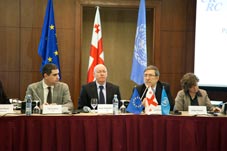
Professional Media for Elections releases monitoring results
By Keti Arjevanidze
Wednesday, February 27
The Caucasus Research Resource Center (CRRC), Internews – Georgia, the International Society for Fair Elections and Democracy (ISFED) and the Civic Development Institute, introduced the media monitoring results of the 2012 Parliamentary Elections in Georgia and shared the major findings of the election media monitoring on February 26. The project Professional Media for Elections, supported by the European Union (EU) and the United Nations Development Programme (UNDP), was carried out from May to November, 2012 in cooperation with the Slovak organization MEMO 98.
Quantitative and qualitative monitoring was performed on the Georgian TV, radio, press and online media.
TV monitoring was divided into two parts: the observation on news programs and political talk shows. Election monitoring of talk shows was performed for all the talk shows, which were broadcast during prime time and were dedicated to political topics. 7 channels and talk shows were under their observation.
CRRC representative Mariam Kobaladze said that there were several faults noticed during the observation process. Namely she said that there was a “blurred” delimitation between the politicians’ official activities and the election campaign during the coverage.
Kobaladze emphasized that the Georgian Public Broadcaster (GPB) a month earlier to the parliamentary elections, was much more balanced then previously, adding that before several cases of bias were identified on GPB, “specifically showing the president in a positive context.”
Giorgi Jologua from Civil Development Institute presented major findings in online media. According to him, all the web-sites actively covered the polling day for the parliamentary elections and the subsequent events.
The most intensively covered political subjects were: the Georgian Dream Coalition, the president, the government, the Central Election Commission and the National Movement. According to Civil Development Institute findings, quite a high indicator of neutral tone was observed on the web-sites. Jologua singled out several online outlets which were unified under the identical features during the election period– specifically the unifying features for Netagzeti.ge and Civil.ge had analytical articles, a high level of protecting the standards, diversity of sources and the accuracy of facts.
ISFED monitored 10 Georgian print editions. It identified several key findings to overall tendencies. Similar to the election period, the Coalition Georgian Dream was the most actively covered subject, but after the new government started functioning, the space dedicated to the government increased significantly.
The tone towards the Georgian Dream was mostly neutral in the outlets except several print editions.
Presenting the findings from 12 Georgian radio stations, Internews-Georgia reported that compared to the previous monitoring periods, the highest frequency rate referred to politicians. According to Diana Chachua from Internews-Georgia, a high rate of coverage during this period was caused by the events developed in connection to the prisons and by the elections as well.
Lasha Tughushi, editor-in chief of Rezonansi newspaper, said that in the future, it would be better to widen the monitoring timeline. “These results (TV Monitoring results) show the data only from prime time observation, which does not give the complete picture of the real situation,” Tughushi said.
Jamie McGoldrick UNDP Resident Representative in Georgia, hoped for the development of unbiased, professional media in Georgia and emphasized that media is accountable to the public. “People should understand the issues better,” he said adding that Georgia continues development but it should be reflected on the media as well.
Philip Dimitrov the head of the EU mission in Georgia underlined Georgia’s development. He said the monitoring of media outlets should continue in the future, despite the critical opinions “that may exist.”
Final results of the monitoring are available on www.mediamonitor.ge.

